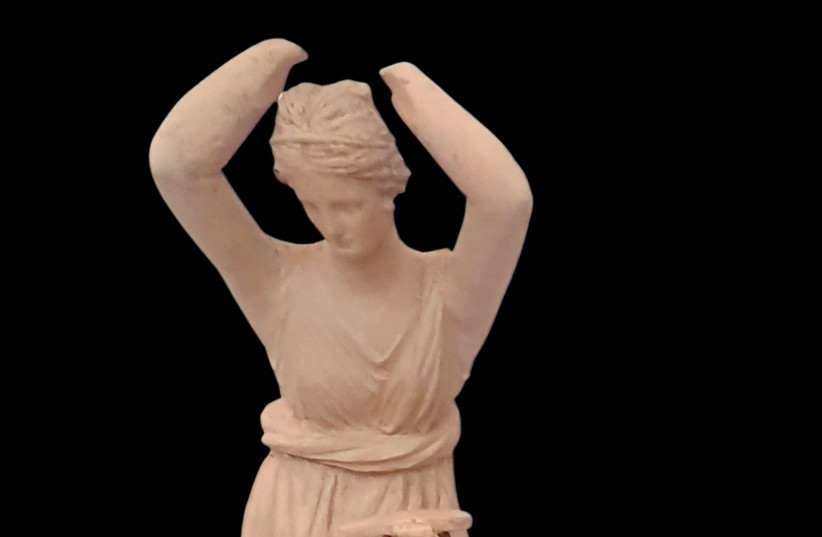A burial cave containing the cremated remains of a young woman of Greek origin – apparently a courtesan (professional mistress) of a high official in the army and the Hellenistic government as he traveled through the Land of Israel – has been uncovered in excavations on Via (Derech) Hebron in south Jerusalem.
She was buried with a rare bronze box mirror that was found in a perfect state of preservation. The discovery, said the Israel Antiquities Authority (IAA) opens an “extraordinary window into the funerary customs that were imported to the Land of Israel along with the Hellenistic occupation.
The findings will be presented for the first time at the conference New Studies in the Archaeology of Jerusalem and Its Region of the Israel Antiquities Authority, Tel Aviv University (TAU) and the Hebrew University of Jerusalem (HU) to be held on October 11th and 12th.
Kings and noblemen often kept a mistress (prostitute) with whom they had a relationship but to whom they were not married. The word courtesan gets its name from a royal court. The tomb of the courtesan (hetaira in ancient Greek) dates from the late 4th century to early 3rd century BCE.
What did they find in the burial cave?

The burial cave is rare evidence of the Hellenistic period in the Jerusalem area. It was discovered on a rocky slope not far from Kibbutz Ramat Rahel. Dr. Yossi Nagar, the IAA’s physical anthropologist, identified the charred human bones as those of a woman. According to Dr. Guy Stiebel from TAU’s archeology and ancient Near East department, “this is, in fact, the earliest evidence in Israel of cremation in the Hellenistic period.”
A number of bent iron nails were found next to the bones, and to the surprise of the archaeologists, a “grave-good” was further discovered next to the charred woman’s bones – a rare type of folding bronze mirror box.
"This is only the second mirror of this type that has been discovered to date in Israel, and in total, only 63 mirrors of this type are known around the Hellenistic world,” added Liat Oz, director of the excavation on behalf of the IAA. “The quality of the mirror’s production is so high that it was preserved in excellent condition, and it looked as if it was made yesterday.”
The researchers noted that this offering of folding box mirrors was documented in tombs and temples in the Greco-Hellenistic world and is a clear indication of a gendered artifact involving Greek women. The box mirrors were usually decorated with engravings or magnificent reliefs of idealized female figures and goddess figures – particularly that of Aphrodite, the goddess of love.
“The most stimulating question arising from this discovery was what the tomb of a Greek woman was doing on the highway leading to Jerusalem, far from any site or settlement of the period. The tomb particularly intrigued us, also due to the fact that the archaeological information regarding Jerusalem and its surroundings in the early Hellenistic period is very scarce,” Stiebel added.
To solve this riddle, the team had at their disposal a number of unique data that characterized the burial from Via Hebron that shed light on a surprising narrative – the rare and expensive box mirror and the cremation that is well known in the Greek world, as well as the finding of the iron nails in the burial.
As for the woman’s status, they believe she was probably a courtesan rather than a wife since married women rarely left their home in Greece – not to mention joining their husbands on military campaigns. The fact that there was no settlement near the burial cave apparently indicates that this is the tomb of a Greek woman who was buried on the roadside.
“Bronze mirrors like the one that was found were considered an expensive luxury item, and they could come into the possession of Greek women in two ways – as part of their dowry prior to a wedding or as a gift given by men to their hetairai. As such, the mirrors symbolized, among other things, the connection – as well as the intimate relations between the clients and their mistresses. The hetairai formed part of an Ancient Greek social institution, in the framework of which women – similar to Japanese geishas – provided social escort services, and not necessarily only, or mainly, sexual services. Some of them became common-law spouses of the Greco-Hellenistic rulers as well as of high-ranking generals and famous intellectuals. The hetairai held literary salons, and served as muses for the most famous works of sculpture and painting that were even displayed in temples.
“It is most likely that this is the tomb of a Greek woman who accompanied a senior member of the Hellenistic army or government, during Alexander the Great’s campaigns or more likely during The Wars of the Diadochi (successors),” the researchers concluded.
“This is an example of the combination of archaeology and research at its best,” said IAI director-general Eli Escuzido. The study of a seemingly simple object leads us to a new understanding and a narrative, that opens a window for us to a forgotten and vanished ancient world. These days, researchers are using more technologies to extract more information, and maybe we will be able to get to know that lady and her culture better.”
In follow-up study to be carried out soon, the researchers intend to gain more pinpointed data regarding the origin of the mirror’s production in an attempt to shed additional light on the woman's background and perhaps even on the origin of the senior official she accompanied.
